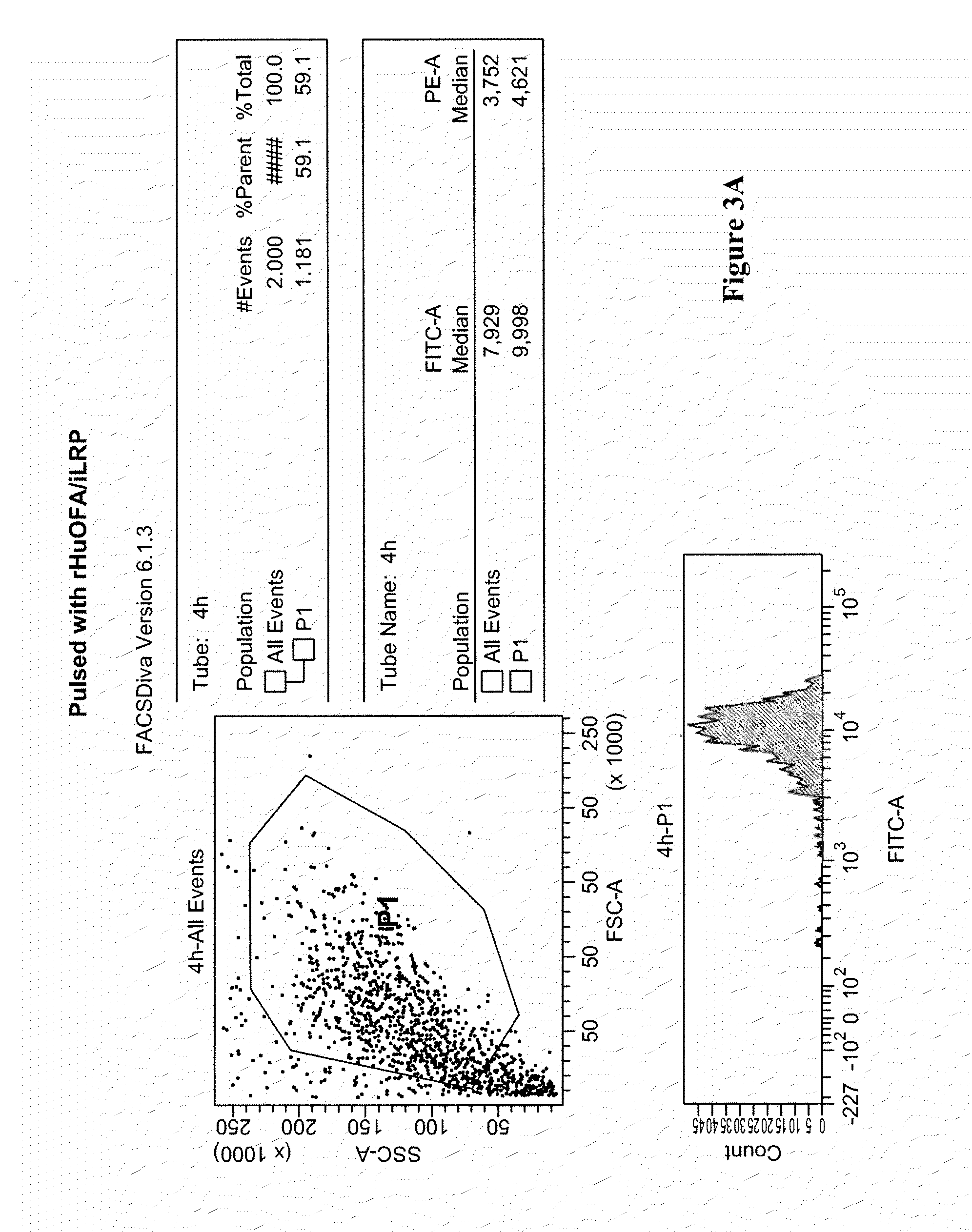Oncofetal Antigen/Immature Laminin Receptor Peptides for the Sensitization of Dendritic Cells for Cancer Therapy
a technology of immunomodulatory laminin and peptide, which is applied in the field of oncofetal antigen/immature laminin receptor protein, can solve the problems of high probability of missing useful protein sequences that could be recognized if the full-length protein was processed, putative hla (human leukocyte antigen) site can still be missed or not recognized by the immune system, and the use of sequential peptides, while informative, has a high probability of missing useful
- Summary
- Abstract
- Description
- Claims
- Application Information
AI Technical Summary
Benefits of technology
Problems solved by technology
Method used
Image
Examples
example 1
Peptide Predictions and Binding to OFA-Sensitized Dendritic Cells
[0087]Several regions were predicted using the computer-based clustering methods (FIG. 2). The region starting at amino acid 129 (Ac-CADHQPLTEASYVNLPT-amide) was chosen because it can be used to further demonstrate the effect of peptide modifications. Additionally, 129 is in a region that was shown not to contain an epitope and lacks half of the YVNLPTIAL epitope shown to be required by previous studies {Rohrer, 2006 #1}. To determine if the 129 region is antigenic, dendritic cells were pulsed with full-length recombinant human OFA, matured and analyzed for 129 epitope using a fluorscein-labeled peptide (FIG. 3A& C).
[0088]CD 14+ monocytes were grown in serum-free dendritic cell medium containing: 1000 IU / ml GM-CSF and 1000 IU / ml of IL-4 (Cell Genix Antioch, IL) at 1×106 cells per ml. The cells were pulsed with rHu OFA at 100 ng / ml or an equal mixture of the peptides (20 ng / ml) of:
(129)CPRADHQPLTEASYVNLPT —OH;(117)FREPR...
example 2
Effect of Peptide Modifications on Dendritic Cell Binding of the 129 Regions
[0093]Several regions were predicted using the computer-based clustering methods (FIG. 2). The region starting at amino acid 129 (Ac-CADHQPLTEASYVNLPT-amide) was chosen because it can be used to further demonstrate the effect of peptide modifications. To determine if the 129 region can improve its relative binding to dendritic cells, the peptide sequence was modified on the carboxyl end to include 4 additional amino acids and the amino end included an 6-aminohexanoyl as a spacer to minimize binding hindrances. These modifications should increase the median fluorescent intensity when compared to the standard 129 peptide.
[0094]CD 14+ monocytes were grown in serum-free dendritic cell medium containing: 1000 IU / ml GM-CSF and 1000 IU / ml of IL-4 (Cell Genix Antioch, IL) at 1×106 cells per ml. The cells were pulsed with rHu OFA at 100 ng / ml for 36 hours. The pulsed dendritic cells were matured using serum-free dend...
example 3
Innocyte 96-Well Cell Adhesion Assay
[0099]The goal of this experiment was to determine if the peptides designed against OFA / iLRP had any effect on cell adhesion of an adherent cell line to extracellular matrix components. The desired response is that there is no change in adhesion since decreased adhesion could increase metastatic potential.
[0100]All cells were grown in RPMI 1640 with L-glutamine, 100 I.U. Penicillin, 100 μg / ml Streptomycin, and 10% fetal calf serum at 37° C. in a humid chamber (Mediatech, Inc. Manassas, Va.). DU-145 AND SK-MEL-28 cells were obtained from American Type Culture Collection (ATCC, Manassas, Va.) and grown in media following standard protocols. Cells were grown to between 75 and 85% density and collected following standard protocols and counted using a modified Neubauer brightline hemacytometer and suspended at 400,000 cell / ml.
[0101]Peptides were dissolved in either phosphate buffered saline (PBS) or DMSO and then PBS to a maximum of 20% DMSO and a 2× s...
PUM
| Property | Measurement | Unit |
|---|---|---|
| Composition | aaaaa | aaaaa |
| Diameter | aaaaa | aaaaa |
| Solubility (mass) | aaaaa | aaaaa |
Abstract
Description
Claims
Application Information
 Login to view more
Login to view more - R&D Engineer
- R&D Manager
- IP Professional
- Industry Leading Data Capabilities
- Powerful AI technology
- Patent DNA Extraction
Browse by: Latest US Patents, China's latest patents, Technical Efficacy Thesaurus, Application Domain, Technology Topic.
© 2024 PatSnap. All rights reserved.Legal|Privacy policy|Modern Slavery Act Transparency Statement|Sitemap



